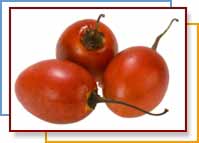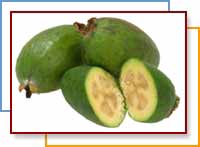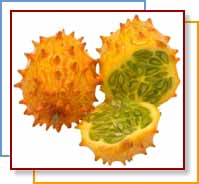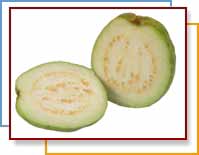
Exotic fruits are becoming more available throughout the year in the
United States. Many of the fruits described below are grown in the
Southern Hemisphere, where our winter is their summer. Importing fruits
from countries such as New Zealand allows Americans the opportunity to try
new fruits all year round.
 The tamarillo is egg-shaped and is pointed at both ends with a green
stem. The skin is tough and bitter and may be red, purple, amber, or
golden yellow in color. The outer layer of apricot-colored flesh is
slightly firm and the inside is filled with dark edible seeds that are
slightly harder than those of a tomato. The flesh is tangy and tart, but
flavorful. Tamarillos are native to South America, but most tamarillos
sold in the United States are imported from New Zealand. This fruit is popular in
South and Central America, the Caribbean, parts of Asia, and Australia. It
is also commonly called a tree tomato. The tamarillo is egg-shaped and is pointed at both ends with a green
stem. The skin is tough and bitter and may be red, purple, amber, or
golden yellow in color. The outer layer of apricot-colored flesh is
slightly firm and the inside is filled with dark edible seeds that are
slightly harder than those of a tomato. The flesh is tangy and tart, but
flavorful. Tamarillos are native to South America, but most tamarillos
sold in the United States are imported from New Zealand. This fruit is popular in
South and Central America, the Caribbean, parts of Asia, and Australia. It
is also commonly called a tree tomato.
Selection
Select fruit that is firm, unblemished and is heavy for its size. When
ripe, tamarillos should be fragrant and should yield slightly to gentle
pressure. Tamarillos are available from May to October in specialty stores and some supermarkets. They can occasionally be found out of
season.
Storage
Tamarillos may be ripened at room temperature, then stored in the
refrigerator or eaten once they are ripe. They last up to ten days in the
refrigerator if wrapped in a plastic. Tamarillos may also be frozen if
they are peeled and wrapped individually.
Preparation
Tamarillos should be peeled before eating or cooking. Blanching in boiling
water for 2 to 3 minutes is often the easiest way to remove the skin if
the fruit is not ripe. They are often eaten raw, when ripe. Dip in frozen
orange juice concentrate to sweeten the fruit and add to fruit or
vegetable salads. Tamarilos are also often made into jams, chutneys and
relishes.
| |
|
Feijoa |
Serving Size
50g
|
Amount Per Serving |
% Daily Value |
| Calories 25 |
|
| Calories from
Fat 5g |
|
|
Total Fat 0g |
0% |
|
Saturated Fat 0g |
0% |
|
Sodium 0mg |
0% |
|
Total Carbohydrate 5g |
2% |
|
Dietary Fiber 2g |
7% |
| Sugars
0g |
|
| Protein 1g |
|
|
Vitamin A |
0% |
|
Vitamin C |
15% |
|
Calcium |
0% |
|
Iron |
0% |
* Percent Daily Values are based on a
2,000 calorie diet.
|
|
| |
|
The feijoa is also an egg-shaped fruit with a thin lime-green skin. The
flesh inside is cream-colored and encases a jelly-like center. The texture
is gritty, close to that of a pear. The flesh tastes like a combination of
several other fruits, usually described as pineapple, guava, and
strawberry. Some people report a taste similar to that of a quince or
lemon. Feijoa is native to South America, but is now commercially grown in
New Zealand and California. It is also commonly called a pineapple guava.
Selection
Select fruit that is fragrant and gives slightly to gentle pressure. Ripe
feijoas are delicate, so take caution not to bruise the fruit. Imported
feijoas are available from late March to June; while domestic ones reach
the market in the fall. Feijoas are gaining in popularity and are becoming
easier to find in supermarkets. They are already easy to find in specialty
markets and can often be ordered out-of-season through several online
merchants.
Storage
Ripe feijoas may be refrigerated, but they don’t have to be. Ripen feijoas
in a paper bag at room temperature; to ripen quicker add an apple to the
bag. Ripe feijoas normally last about 3 to 5 days. Feijoas may be frozen,
but only if peeled and cooked into a puree.
Preparation
Feijoas are most often eaten raw. The fruit is ripe when it is slightly
soft and the jellied inner section is clear. The fruit is unripe when the
jelly is white and is spoiled when the jelly is brown. Unfortunately, this
test of ripeness may only be determined once the fruit is opened. Peel the
fruit before preparing, as the skin is bitter.
| |
| Red
Banana |
Serving Size
99g
|
Amount Per Serving |
% Daily Value |
| Calories 90 |
|
| Calories from
Fat 5g |
|
|
Total Fat 0g |
0% |
|
Saturated Fat 0g |
0% |
|
Sodium 0mg |
0% |
|
Total Carbohydrate 23g |
8% |
|
Dietary Fiber 1g |
4% |
| Sugars
16g |
|
| Protein 1g |
|
|
Vitamin A |
2% |
|
Vitamin C |
15% |
|
Calcium |
0% |
|
Iron |
2% |
* Percent Daily Values are based on a
2,000 calorie diet.
|
|
| |
|
Red bananas are smaller in size than a common banana and the peel is a
deep red or purple. It has a creamy white to pink flesh, with a slight
raspberry-banana flavor. The overall taste is similar to a common yellow
banana. They are imported from Costa Rica and are a favorite in Central
America.
Selection
Select firm bananas free from bruises or cracks in the peel and look for a
deep purple color. This indicates the banana is ripe. If the color of the
peel is lighter, the banana is not ripe. As with common yellow bananas,
red bananas will ripen in a couple of days at room temperature. Red
bananas are available year round at specialty markets and larger
supermarkets.
Storage
Store bananas at room temperature, do not refrigerate. Turn bananas
occasionally and store them in an uncovered location.
Preparation
Peel fruit prior to eating. Red bananas are used in similar ways as common
yellow bananas. They are most frequently eaten whole raw or chopped and
added to desserts or fruit salads. Red bananas are one of varieties
commonly used for store bought dried bananas.
Kiwano melon is an oval shaped fruit with horns on its peel. It has a
bright orange and yellow skin with a pale yellow-green pulp inside. The
flavor of the pulp is sweet and a bit tart with a flavor mix of bananas,
lime and cucumber. Kiwano melon is native to southern and central Africa
and is commonly known as an African horned melon. Most imported melons are
now from New Zealand. California has began growing this melon, so a
domestic product is available part of the year.
Selection
 Select melons without any bruises or spots with a bright orange color. It
is best to purchase a melon that has the horns intact, as damaged horns
may be a sign of rough handling. Kiwano melons are available year round in
specialty markets and supermarkets. Select melons without any bruises or spots with a bright orange color. It
is best to purchase a melon that has the horns intact, as damaged horns
may be a sign of rough handling. Kiwano melons are available year round in
specialty markets and supermarkets.
Storage
Unripe melons may be stored at room temperature for up to two weeks. Ripe
melons will last about 3 to 4 days at room temperature. There is no need
to refrigerate kiwano melon.
Preparation
There is no way to peel the skin off of the melon, so the fruit needs to
be scooped out of the melon before using. The melon may be cut in half or
into wedges to help extract the fruit pulp. The pulp may be eaten by
itself, used as a topping for a sweet dessert or added to a fruit or green
salad. The shell may be used as a serving dish once the pulp is removed,
but the skin should not be eaten.
| |
|
Guava |
Serving Size
1/2 cup raw (83g)
|
Amount Per Serving |
% Daily Value |
| Calories 40 |
|
| Calories from
Fat 5g |
|
|
Total Fat 0g |
0% |
|
Saturated Fat 0g |
0% |
|
Sodium 0mg |
0% |
|
Total Carbohydrate 10g |
3% |
|
Dietary Fiber 4g |
14% |
| Sugars
5g |
|
| Protein 1g |
|
|
Vitamin A |
10% |
|
Vitamin C |
250% |
|
Calcium |
2% |
|
Iron |
2% |
* Percent Daily Values are based on a
2,000 calorie diet.
|
|
| |
|
Guava is an oval shaped fruit that varies in size from a small egg to a
medium apple. The thin skin may be yellow, red, purple or nearly black and
the flesh ranges from a pale yellow to a bright red. Guava is sweet with a
slight tart aftertaste. Its texture is firm; similar to an apple. Guava is
native to South America, but is now commonly grown in California, Florida
and Hawaii. It is also known as a Bangkok Apple or Guayaba.
Selection
Select fruit that gives to gentle pressure and is unblemished. Fresh guavas
are often only available in the region near where they are grown, but may be
ordered by mail. Canned guava products are available nationwide throughout
the year in larger supermarkets.
Storage
Store ripe guavas in the refrigerator for up to a week. Green, unripe guavas
should be stored at room temperature until ripe. Ripe guavas stored at room
temperature will spoil quickly; normally within a couple of a days.
Preparation
The entire guava is edible. The rind and small seeds inside, along with the
creamy flesh are often used in making jellies, preserves, and sauce. To be
eaten raw, guava needs to be very ripe. Guava is typically sliced lengthwise
into 5 or 6 slices and seeds discarded.

Recipes
Tropical Fruit Salad with Guava Sauce
Makes 4 servings
Each serving equals 1 1/2 cups of fruit or vegetables
Ingredients
2 bananas, sliced
1 ripe pear, sliced
4 kiwis, peeled and sliced
2 cups sliced strawberries
2 feijoas
2 Tbsp orange juice concentrate
1 ripe guava
Combine all of the ingredients, except for the juice and guava, in a
large serving bowl. Peel and slice the guava into quarters and place in a
blender with the orange juice concentrate. Puree until smooth. Pour the
mixture through a sieve to remove the seeds and pour over the fruit salad.
Nutritional analysis per serving: Calories 212, Fat 2g, Calories
from Fat 6%, Protein 3g, Carbohydrates 52g, Fiber 9g, Cholesterol 0mg,
Sodium 8mg.
Find more in our
recipe database!
|



